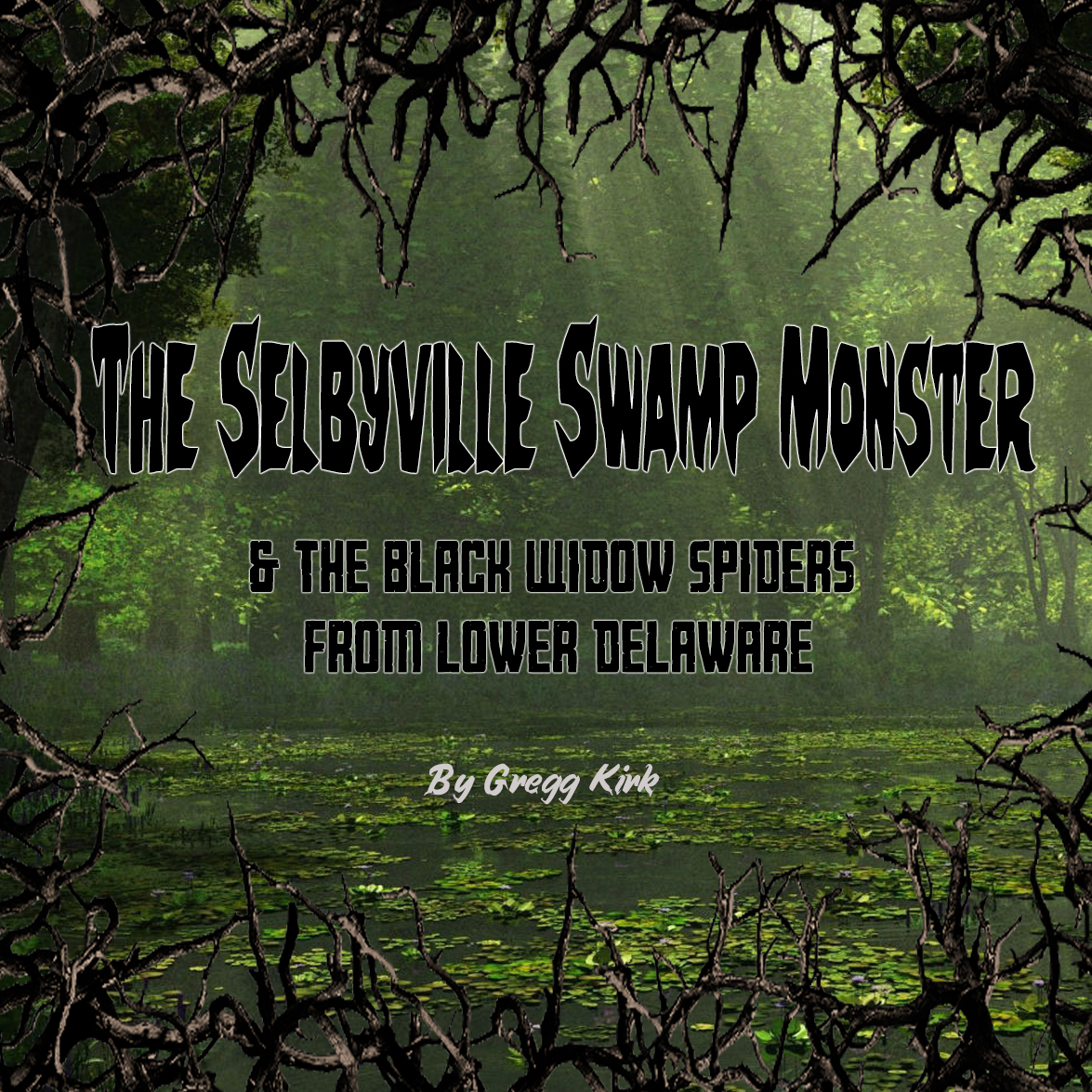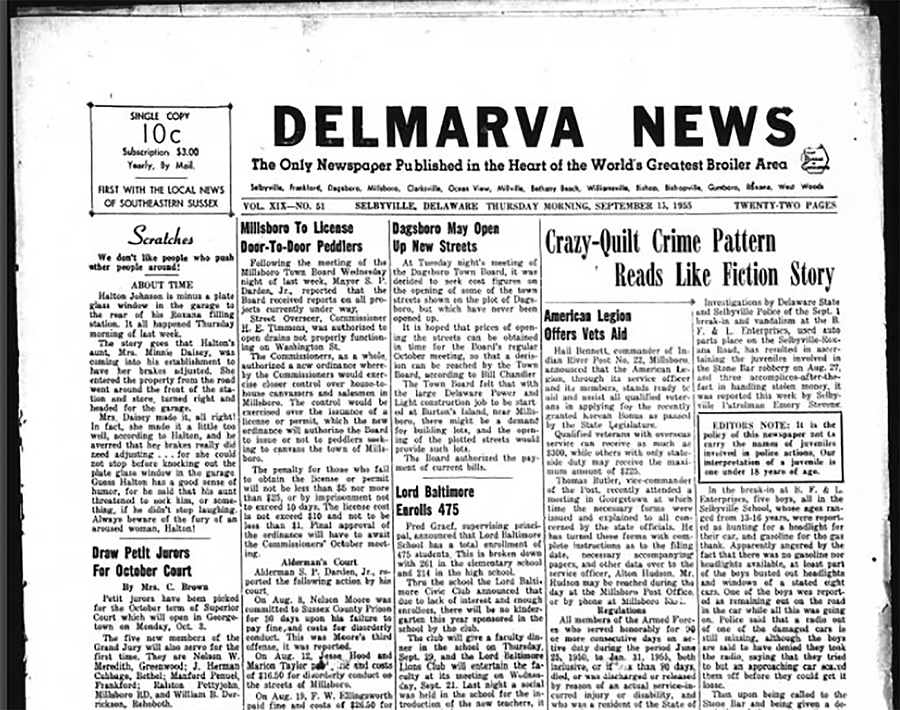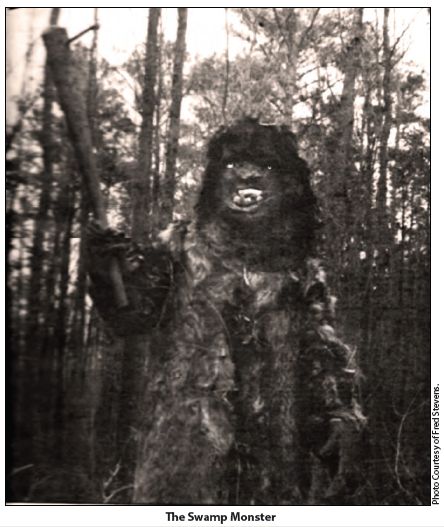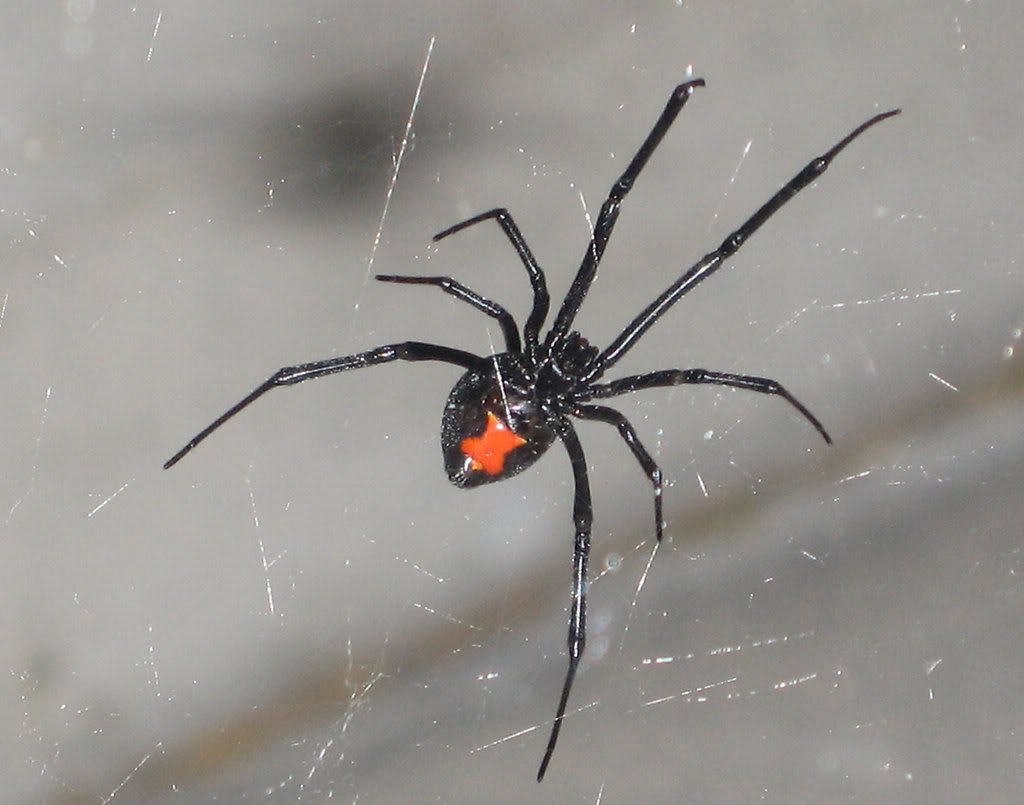The Selbyville Swamp Monster & the Black Widow Spiders of Lower Delaware

Remember when a 25-year-old reporter from lower Delaware debunked a decades-long monster hoax and solved a regional mystery on the sudden invasion of black widow spiders in Sussex County, DE in the 1980s? You don’t? Read on…
In the spring of 1986, my girlfriend and I decided to take a chance and move from New Castle County, DE to the beach region in the southern part of the state. We had no prospects and were fresh out of college, but the first thing we did was contact one of the local newspapers and score interviews in just our first call. We walked into the office together, met with the hiring manager and because my girlfriend mentioned she had sales experience, she was hired on the spot. Because I showed my writing credentials, I was told to come back at another time.
A friend offered to let us stay in his beach apartment rent-free until we could get on our feet, so we committed to moving there full time. My girlfriend started selling ads for the newspaper company that owned several regional weeklies, and I was eventually offered a low-paying job running a stat camera. This entailed me spending 10-hour days in a dark room, resizing photos and ads that would be pasted up in these local papers. It was a far cry from the glamorous beach life I had been expecting, and even though we lived right across the street from the beach itself, I only had time to go there twice that year.
This grind began to get to me, and I pleaded with the owners of the newspaper company to hire me as a writer, but to no avail. When I noticed an ad for an entry-level reporter position at a competing paper, I ditched my pride and any loyalty I had felt and interviewed there. The newspaper in question was not like the entertainment-oriented beach papers where I had worked before. This was an inland hard-news weekly that was full of farm reports, county council meetings and planning and zoning updates. I couldn’t have been more out of my depth, but I took the position because it was something that involved writing and didn’t require me to spend hours in a dark, enclosed space around toxic photo chemicals.
My first day on the job, I was sent to my first county council meeting that was a half-hour drive further inland. I was told by my editor that I would have about 20 minutes to write my story when I got back. Cold sweat rolled down my back as I sat in the audience gallery of the council meeting, listening to elderly men speak what sounded like another language. Everyone seemed to be heated about a new property that was being proposed, and several people began arguing about EDUs. What the hell was THAT?
The meeting adjourned, and I looked at my notes, and I couldn’t make sense of them. I sat down in defeat on the front steps of the council building puzzling over what I would actually write about. This apparently attracted the attention of one of the older, grizzled reporters who introduced himself. He could tell I was confused, and I didn’t waste any time asking him what the hell an EDU was.
“It stands for equivalent dwelling unit,” he said. When I looked at him like he had spoken Greek words to me, he explained, “It’s a toilet. Everyone down here is concerned about how these new buildings will affect groundwater and the nearby wetlands.”
That’s all I needed to hear, and I sped back to the office and logged my first article, just in time to make our print deadline. It didn’t take me long to get acclimated and within a few months I was also covering planning & zoning commission meetings, ribbon cuttings, and high school sports events.
After working at this paper for about six months, I began to hit my stride and make a few friends at the paper and with some of the locals. Even though the office was located only half an hour inland from where my girlfriend and I lived at the beach, the town and our paper’s coverage area was a different world. The population could best be described as rural with a majority of the citizenry in or nearing retirement-age. In contrast, I was in my early 20s and looked like I was in a rock band (which I was). When I walked down the street to go to lunch, I felt like a martian invader trying to comprehend the local culture, and I was received by the natives as if I were.
Our newspaper office was only a block away from the competing paper, the Delmarva News. We frequently made fun of its vapid content and weak attempts at reporting on anything of substance. We nicknamed it Delmarva Snooze, and I spent most of my time ignoring or mocking what they were doing.
Then one day, I received a call from one of the higher ups at the newspaper company where my girlfriend worked. This was the same guy who had turned me down for writing jobs for almost a year. He had seen my bylines and asked me if I’d be interested in being the editor of the Delmarva News. I was shocked. I was still upset with him for brushing me off in my hours of need, but now I was being offered a position beyond my earlier expectations. And I would be an editor, yes, but for the same crappy publication I’d been making fun of for half a year.

It wasn’t a straight-forward choice, but I accepted the position. The staff at my former newspaper was disgusted with me, and I instantly became their competition and arch enemy.
The new position required me to wear a tie and “look official” to the local townspeople. I was now a public figure of sorts, and I was instructed on how to live up to that image. I also inherited a staff of a half dozen ladies who were almost twice my age and had been working at the Delmarva News for years. From the first minute I stepped into the office to assume the position as their boss, I got the strong impression that I was really nothing more than their mascot.
The staff was fully capable of running all aspects of the business without me, except the “filler” of a few news stories and photos. All of the ads, classifieds, real estate ads, and legal notices were handled like they had been for decades. I just needed to fill a few slots on the front page. Any questions or new ideas I had were met with patronizing smiles. I got the impression they all thought I was cute and amusing… you know, like a harmless clown. We all got along fine as long as I didn’t ask them to do anything outside the ordinary or screw anything up on my part.
Well, the first few weeks I did screw things up badly enough that I could almost hear the laughing and sniggering down the block at my former newspaper office. The guy who hired me actually felt compelled to come in one day to go over every little thing I had gotten wrong in the first few editions under my editorship.
I felt humiliated, depressed, and the hours were never-ending. The job took up almost all waking hours of my life at the time. I felt trapped and powerless to try to improve the reputation of this paper I had once ridiculed.
Then one day, the ad director came into my office with something that looked like a tome from a Harry Potter movie. It was a two-foot long bound book that had the actual printed newspapers from Delmarva News‘ long history. The newspaper was more than 150 years old and actually had a proud heritage. The ad director showed me all of these bound editions and where they resided in the basement of the building. I became a bit obsessed with them.
The Selbyville Swamp Monster
After poring over a few volumes, I came across an April 1964 edition with a front page story about the Selbyville Swamp Monster. Selbyville (pronounced “Subbyville” by the locals), is a neighboring town right on the southern-most border of Delaware. It has a sprawling swamp called the Great Cypress Swamp or Burnt Swamp that is the state’s largest contiguous forest. According to locals, one of whom worked at or our paper, the swamp is so large and bewildering that people often get lost in it and are reported missing every year. Prior to 1964 there had also been reports by hunters of strange creatures lurking in the more wooded areas of the bog.
It became the place of local legend, but in 1964 people began reporting sightings of some sort of hairy, ape-like creature spotted along areas of Cypress Road (Rt. 54). Delmarva News editor Ralph Grapperhaus wrote a few feature stories with a straight-faced approach that included local accounts of what had been seen. Regional news outlets also picked up the story, and the sightings reached a fever pitch until they stopped abruptly in the late 1960s.
Since my news staff had all grown up in the area their entire lives, I showed them the articles and asked them what their recollection was.
“Golly day, it was kind of a big deal for a while,” our receptionist said. “But we later found out it was just Fred Stevens running around in a mask. I went to high school with him.”
She nonchalantly gave me his address and phone number, and by early afternoon I had reached Fred, who agreed to meet me at his house on the outskirts of Selbyville. When I asked him outright if he had posed as the Selbyville Swamp Monster in the 1960s, his reply was intriguing. “I can’t tell you,” he said. “But I have something to show you.”
When I got to Fred’s house, he met me in his driveway and directed me to his open garage where he pointed to a pile of junk in one corner. I didn’t know what I was supposed to be looking at. Then he walked over and picked up a monster mask that was flattened on one side because it had been lying in the same place for a few decades. It showed signs of deterioration with some of its hair falling out.

“I was the Selbyville Swamp Monster,” Fred admitted. “And that’s the mask I wore, but it was all Ralph Grapperhaus’s idea.”
According to Fred, Grapperhaus wanted to concoct a news sensation to jump start the newspaper’s stalling advertising and subscription numbers. He came up with the idea of creating a Bigfoot-like creature that would be seen running around the more traveled parts of the swamp, especially where people drove.
“Ralph asked me to run along areas of Cypress Rd. and to make sure I had been seen by making noise,” Fred said, “and that worked great for awhile.”
Grapperhaus’s idea soon achieved its goal, but after a year or more, things started to spin out of control. Regional radio and TV stations also ran with the story, and “hunting parties” of young locals began to form, outfitted with pickup trucks, shotguns and plenty of “liquid courage” (i.e. beer).
“It got too dangerous for me to be seen at that point, but some people actually scattered chicken parts in areas where I had been seen,” said Stevens. “I guess they were trying to feed me,” he laughed.
I asked Fred if he would like to dust off the mask and costume and pose for a photo for me on the edge of the swamp for old-time sake. “No,” he said, but my son Lee will.”
So Fred, Lee and I drove to one of the old stomping grounds off of Rt. 54, and we found a good place where Lee could don the outfit. At this time, Lee was only about 10 years old, so the costume hung off of him like an oversized coat (which apparently it was. It was Fred’s aunt’s old raccoon coat). The mask also fit rather awkwardly, but I took a shot at a low angle to try to make Lee look larger than life. It didn’t really work, but I ran the photo on the front page of the Delmarva News anyway with the headline, “Selbyville Swamp Monster Uncovered!”
When the issue ran in 1987, I didn’t realize I had successfully broken a regional news story and answered a lot of questions people had been asking for more than 23 years. Within two weeks Mark Chorvinsky the publisher of Strange Magazine contacted me to ask me what I knew about the story.
“I’m the one who wrote it,” I said. “Apparently, Stevens and Grapperhaus had made an agreement not to speak of their ruse, and for some reason Fred decided to tell all of his secrets to me with little or no prompting.”
Chorvinsky was delighted and asked if he could come visit me and also talk to Fred. I readily agreed, and Chorvinsky and a colleague met me in my office a few days later, and I broke out the giant, bound issues that had prompted me to dig into the story. Chorvinsky’s eyes lit up, especially when I showed him the shots I had taken of Lee in Fred’s old costume.
I asked him to send me a copy and to give me credit when and if he ran his story, but I never heard from him again. I believe it ran a few years later in 1989, but I can’t find the issue. As a final epitaph to the story, Fred Stevens passed away earlier in 2021, and his son Lee has moved out of the area. I believe we have finally seen the last of the Selbyville Swamp Monster, at least the masked version.
The Black Widow Spiders of Lower Delaware
This story approach gave me a new lease on life at the paper. It gained me the respect of my staff, and their patronizing smiles turned to outright affection. I had proved not to be a bumbling fool after all. It also taught me that I could make my job fun if I decided to run these offbeat stories instead of the typical church potluck announcements or puff pieces featuring employees at the local chicken-processing plants.
One day I asked the staff if they had any other leads comparable to something like the Swamp Monster story. One of the younger production staff told me her boyfriend kept finding black widow spiders while on the job as a cable installer. Black widows are not known to live outside of warm climates, but this girl told me her boyfriend was finding them in cable boxes all around town, even during the winter months. Apparently, these boxes had electrical current running through them that gave off a bit of heat that attracted the spiders. The question was, was this really happening on a grand scale, and if so, how were these invading spiders getting to Delaware?

I asked the production girl if her boyfriend could provide proof, and the next day she showed up with a glass jar containing two perfect examples of live black widow spiders. I took a picture of it and ran a short story about it on the front page. The public response was possibly stronger than the swamp monster story. Within days, I had farmhands, other cable installers, and repairmen showing up to my office with jars of varieties of black widow spiders I didn’t know existed. The classic-looking black widow is actually rather small… less than an inch in diameter. But some of the donated spiders were three times this size and had large bellies the size of a quarter that also had impressive red and white stripes coursing down them. All of them had some version of a red hourglass marking on their belly, and all of them were more than likely poisonous. None of the ladies in our office were happy with this turn of events, and they started calling me “spider man.”
I ran a second article showing more of the spiders with a call to the locals to help me solve the mystery. Black widow spiders were not known to migrate this far north because they didn’t typically prefer the colder climate. It didn’t make sense that southern Delaware was experiencing what seemed to be an actual infestation of an invasive species that also happened to be poisonous. Mind you, a black widow bite is rarely fatal to an adult human, but it can cause serious harm to smaller animals, children, and the elderly if a bite occurs near the heart or head & neck area.
As you can imagine, the second article created a full-blown stir, and I received a call from a woman representing the local hospital. She accused me of trying to generate a sensation and a panic. After all, Delmarva News had a proven history of doing just that. Instead of trying to defend myself, I invited her to come to my office to gaze upon the 12 jars of black widow spiders I was currently keeping safe. She cordially declined and then offered to run a seminar at the hospital on what someone should do if bitten by a spider. The seminar wasn’t specific to black widows, but that day the Truth prevailed.
I ended up solving the mystery and breaking the story by finding out that cucumbers were being driven up on trucks from southern states and then delivered to the Vlasic pickle plant in Millsboro, DE. The spiders were riding along with the cucumbers and being unwittingly relocated. A friend of mine who worked at this plant told me the workers had to be careful because they would routinely find black widows among the cucumber bunches.
All operations at the plant ceased by the end of 2012, and the building was purchased by Allen Harim, a chicken processing company that also has a processing plant in Harbeson, DE and a hatchery in nearby Dagsboro, DE.
Because of this, I would expect that the influx of black widow spiders streaming in from the southern states would have also ceased, but according to local reports, the spiders are still being found in cable boxes and farmland across Sussex County. It doesn’t matter that there are no new spiders being imported into Delaware anymore. The black widow spiders have effectively established a strong colony and seem to be there to stay.
The change in business focus of the former pickle plant also underlines another interesting fact about the state and “invasive species.” Apparently, there are more live chickens in the state of Delaware than humans by a factor of approximately 200-1, according to WHYY local news. To put that into perspective as of 2021, Delaware’s population is estimated to be 990,334 humans. That means there are probably more than 198 million chickens currently in the state. Look for a future story on the rise of the angry Delaware chickens!



0 Comments